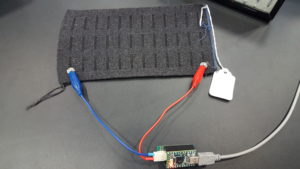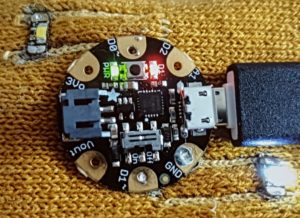With breakthrough technologies and standards under development, it’s been a turning point year for e-textiles.
IFAI’s Expo 2018 in Dallas in October offered a good variety of topics in its presentations and a range of products across advanced textiles markets. Medical and health, protective and safety, smart fabrics, solar textiles and military applications were among the notable market segments. But there was clearly special interest in e-textiles at this major industry event.
Work on standards begins

Multiple sessions were devoted to this timely topic, including the most significant news that work on standards for e-textiles is now underway. Chris Jorgenson, director, technology transfer for IPC (Association Connecting Electronics Industries) and the IPC e-textiles committee staff liaison, said that about 125 businesses and individuals have participated in the process thus far, which includes “a good balance of electronics people and textiles people,” according to Stephanie Rodgers, APEX Mills, who co-chairs the committee.
IPC-8921, Requirements for Woven and Knitted Electronic Textiles (E-Textiles) Integrated With, Conductive Fibers, Conductive Yarns and/or Wires will establish classifications for fibers, yarns and wires; adopt terms and definitions from the international standards organization ASTM; standardize key performance characteristics; and set quality assurance provisions such as test frequency. Furthermore, the committee has compiled a list of specific test methods already in use in the industry that are useful for assessing e-textiles.
A working draft of this standard, which was written by 19 of the committee members, will be submitted to the full committee for comment by spring 2019. It expects to publish the standard by the end of 2019.
Eileen Hill, International Trade Administration, U.S. Dept. of Commerce, said “We relied on standards. … FDA is not the experts; you are the experts on your device.” Hill was referring to her work previously as a regulator of medical devices, but made the comparison with the process of developing e-textiles standards currently, and added, “We’re really making progress.”
The committee has also published its first white paper, which is on washability in e-textiles. Jorgensen says the committee would like to build a library of white papers, and he encouraged others to submit papers or proposals. All the members of the standards panel discussion encouraged participation in the on-going process to develop a full range of e-textiles standards. A designation system has been set up that ultimately allows for 90 standards.
“Standards are a living document,” Jorgensen said. “They can be altered or have addendums.”
Also of importance is the international application of standards developed in the U.S. “You generally will automatically meet [international] regulations, without additional testing,” Hill said.
Military application

Novel and innovative approaches to e-textiles and e-textile products were showcased by exhibitors and in presentations. Pawtucket, Rhode Island-based Propel LLC, which develops textile-driven technologies, has been awarded a grant to develop a Smart Integrated Uniform (SIU) for the U.S. Navy that uses conductive yarns and sensors to monitor the wearer’s wellbeing.
Anjali Khemani, who works in design and innovation for the company, and Birgit Leitner, the head of product development, described their work on this project and their continuing research into better ways to integrate conductive yarns into garments. The company has been able, for example, to produce an entire jacket with no seams by using 3D knitting techniques. This could be a breakthrough, they said, for integrating conductive yarns into garments because it allows for the use of different yarns within the same article of clothing.
Lighting the way
H. Lee Wainwright, an e-textile technology consultant, demonstrated a variety of products he’s developed that use fiber optics. Controlled via smartphone app, the system gives users the ability to program the lighting component to alert them for a variety of purposes. His Opti-Coupler™ is a removable smart phone accessory that allows the app to work anywhere, and to be programmed as the user wishes. Since the LED optics have no wires or conductivity, Wainwright says they are safe—and also washable.
The future of “e-fashion,” he says, is in using medical fibers, because they don’t break. He also noted that technology for e-products is getting less expensive, and can be used with “any textile, as long as it’s flexible, including plastics and leather.”
Startup company Lumenus, which shared exhibit space with Volt Smart Yarns, has created a safer lighting system in smart clothing and accessories designed specifically for people running, walking or bicycling. The LEDs in the clothing or backpack activate via a smartphone app and interface with Google Maps to indicate which direction the wearer is turning by a row of lights that points in the wearer’s direction of travel. This is a hands-free function for the user that offers a clear means to alert vehicles sharing the roadway.
Conductive yarn

Matt Kolmes, CEO of Volt Smart Yarns, a division of North Carolina-based Supreme Corp., outlined some of the problems facing wearables in a presentation titled, “What You Didn’t Know about Smart Yarn.” Using exclusive and patented processes, the company can create highly-conductive custom Volt Smart Yarns with specific levels of conductivity, resistance, and strength.
Volt is a yarn made conductive with an inside core of ultra-thin copper wire. One important challenge addressed by the company was that the wire was hard to work with and could break—and washing compounded this issue. Although the conductive textile is flexible, LEDs, sensors and batteries generally are not, so flexible, washable connectors are needed.
Conductive inks and plastisol ink has been used to cover and protect conductive yarn, but scaling up the products is another hurdle. “Who’s going to solder 24 connection points for 100,000 shirts?” he asked.
Heated fabrics require more power and, therefore, a larger battery, or more precisely, the length of the yarn vs. the power vs. the duration at a desired temperature must all be reconciled. “The level of conductivity is key,” he says.
The company has been working with a busbar approach, which allows them to heat a precise area on the fabric. “Now we can reduce the battery size. That’s different—a leap forward,” Kolmes said. “I think we can get four to six hours on a battery about the size of your phone.”
Another challenge, beyond the technological ones, is the “huge gap” between textile people who don’t understand electronics and vice versa, he says. Discussions designed to bring these two areas of expertise together are beginning to payoff, however, with representatives from both industries participating in the Pre-Show Conference and on the Expo show floor.
Printing conductive inks
Another breakthrough technology is not yet available, but the company (Pittsburgh-based Liquid X Printed Metals) expects to have working prototypes in February 2019. In a presentation titled, “Inkjet Printing of Particle-Free Conductive Inks for E-Textile Applications,” sales and marketing manager Bill Babe said his company “does direct on-fabric printing, which has high throughput, is easily scalable and easily integrated into current manufacturing processes.”
The particle-free technology offers a highly conductive coating on fabric fibers, has a low temperature cure, less jet clogging, and the ability to withstand bending and stretching. The company is developing the process for smart garments, wearable medical sensors, resistive heaters (including wearables and in vehicle heated seats), batteries or supercapacitors and textile based connectors in vehicles. The process can be used with a variety of textiles. “Pretty much any kind,” he said.
The company is a Carnegie Mellon University startup, but the initial collaboration effort began with Prof. Jesse Jur, North Carolina State University.
Janet Preus is senior editor of Advanced Textiles Source. She can be reached at jlpreus@ifai.com.
 TEXTILES.ORG
TEXTILES.ORG


